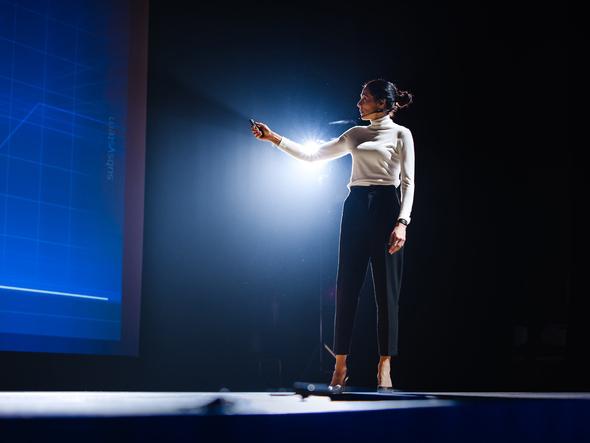A standard in my Hospitality Futures class has been an end-of-semester presentation where students outline a societal trend and provide implications of it on the greater industry. Before Covid, this had not presented problems. However, I now regularly have students willing to take the zero and the accompanying grade penalty instead of making the public presentation. Others often ask to attend class via Zoom. This is not due to illness but, rather, because they “can’t face people today”. Although students are not necessarily less talkative with their peers or me one-on-one, there are signs of resistance when asked to present in front of others.
Other educators have reported similarly on the challenges of the post-Covid classroom in the realms of communication, interpersonal skills and anxiety about live interactions with others. Improvisational (improv) theatre techniques can provide another tool in addressing these issues.
At its core, improv theatre revolves around spontaneity, quick thinking and effective communication, qualities that are highly desirable in both academic and professional settings. In the classroom, improv exercises can be used to sharpen students’ verbal and nonverbal communication skills. By using the basic tenets of improv, such as “yes, and…”, students learn the art of active listening and constructive dialogue. This type of interaction fosters an environment where every contribution is valued and develops students’ confidence in expressing thoughts and ideas with less fear of judgement.
- THE podcast: human connection and the student experience
- How to create extracurricular activities students will want to attend
- Why micro-mentoring works for Generation Z
The use of improv can encourage adaptability and flexibility in communication, preparing students to navigate diverse social situations with less apprehension. Through improv scenarios that require quick decision-making and adaptability, students learn to think on their feet, articulate ideas more clearly and collaborate effectively with their peers. It has been noted that these skills can spill over to personal relationships, reducing anxiety, and improving teamwork and preparation for future career endeavours.
Cultivating agreement and collaboration
In the collaborative aspect of improv comedy, performers rely on each other to co-create narratives in real time. The goal is to move seamlessly from divergent to convergent thought without losing one’s own point of view. These collaborations promote unity, trust and a shared sense of purpose among students. By embracing the fundamental principle of affirming and building on each other’s ideas, students learn the importance of cooperation and collective problem-solving.
Students can also develop an appreciation for diverse perspectives and learn to leverage their individual strengths in character-building, storytelling and narrative construction. Whether students are constructing imaginary scenarios or tackling more academically focused, team-based classroom challenges, the foundations of improv assist in creating a supportive environment where creativity can thrive and innovative solutions can emerge. The real and imagined barriers to communication can be dismantled to expose the power of collective intelligence and harness the constructive interaction of teamwork.
Igniting creativity and innovation
For many people, the top-of-mind view of improv comedy is of spontaneity and creativity, as performers draw upon their imaginations to create stories on the spot. In the classroom, it has been found that incorporating improv techniques can spark creativity to encourage students to explore innovative ideas. Through improv exercises that prompt imaginative thinking and creative problem-solving, students learn to think outside the box and embrace ambiguity as a path towards “what if?” scenarios.
The low-stakes, fleeting nature of improv, as it is not typically recorded in the workshop and non-performance phase (if it’s scored or recorded at all) helps create a culture of experimentation and risk-taking, where mistakes are reframed as opportunities for growth and learning. Students develop the confidence to push the boundaries of their creativity. Whether they are role-playing fictional characters or brainstorming novel solutions to problems, students learn to embrace uncertainty. For example, in a mock interview, students must act as a top-tier executive of a major brand on an imagined panel at an industry conference. During the “interview”, students discuss and defend their action plan to help the brand remain relevant given a set of predicted societal changes. The instructor acts as moderator.
Integrating improv into the curriculum
Integrating improv comedy into the classroom does not require the teacher to have a theatrical background or extensive training. In reality, good classroom management should provide the basic skills needed, including establishing trust and building excitement, positive reinforcement and a willingness to have fun.
The educator must, however, adhere to the tenets of agreement: listening, collaboration, failing with joy and a sense of play. The inclusion of improv only works if the leader is willing to let their guard down; trust is built on vulnerability.
These improv exercises and games have been used successfully for beginner teachers:
- “Yes, let’s!” to encourage enthusiastic agreement
- “Three-line scenes” to provide a basis of “yes, and…” communication
- “The ad game” for teamwork, spontaneity and affirming ideas
- “Group counting” to build active listening skills and adherence to nonverbal cues
- “Red ball” for focus and attention
- “Ba da da” to help free the student of their inner editor.
Whether used as icebreakers to energise students at the beginning of a lesson or to reinforce key concepts, improv techniques can create a more robust toolkit for educators seeking to enhance student engagement and foster an interactive learning environment. By embracing the principles of spontaneity, agreement, creativity, empowerment and resilience, educators prepare students to navigate the challenges of the 21st century with confidence and optimism.
Joe Conto is a hospitality professional and a member of the business and hospitality faculty at Paul Smith’s College. He has been with Montreal Improv in Montreal, Quebec, for more than a decade as a student, performer and instructor. He has performed at festivals in New York City, Toronto, Ottawa, Boston, Burlington and Hartford.
If you would like advice and insight from academics and university staff delivered direct to your inbox each week, sign up for the Campus newsletter.




comment